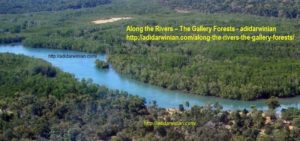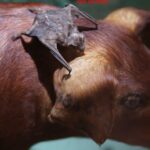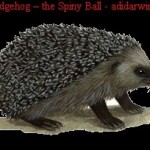Along the Rivers – The Gallery Forests
In this research paper, I have explored the gallery forests by clarifying the concept behind the term “gallery forest”, and studying their biogeography by reviewing some important ecoregions of North America and South America. I have discussed some of the notable gallery forests found in the Americas with respect to their geography, flora, and fauna. It is hoped that this paper will serve the interests of biologists, ecologists, botanists, zoologists, arborists, forest ecologists, biogeologists, biogeographists, and all other people including professionals, students, and laymen eager to learn about the gallery forests.
A gallery forest is a narrow stretch or strip of forest along the banks of a water body, such as a river or stream, flowing through an otherwise open country. In the above context, an open country is defined as a region that is treeless or sparsely covered with trees. A gallery forest is also known as a fringing forest or riparian forest or riverine forest. Such forests are commonly found along the water bodies flowing through the savanna (or savannah) regions. The gallery forests are known to contain different types of woody vegetation. The width of a gallery forest may vary from several miles to complete absence along the same river.
Gallery Forests of the Americas
Some of the notable examples of gallery forests found in the continents of North America and South America are as follows –
Gallery Forests of Llanos Ecoregion
The Venezuelan Llanos and the Llanos Orientales collectively form a single ecoregion called the Los Llanos, or Llanos of the Orinoquia, or just Llanos. The term “Llanos” has been derived from the Spanish word “llano”, which means “plain, even, flat, smooth, or level”. Venezuelan Llanos region includes the tropical grasslands of the western Venezuela. Llanos Orientales region is comprised of the eastern tropical savanna plains of Colombia.
The llanos ecoregion has gallery forests of various types. These gallery forests follow the courses of the rivers and streams of the Llanos ecoregion. In those cases, where the rivers overflow their banks, the gallery forests get flooded to form seasonal swamp forests. In those cases, where the gallery forests occur on the higher banks, they do not get flooded and have semi-deciduous trees of medium height.
The River Meta (Rio Meta) is the principal river of the Llanos Orientales area. A number of tributaries carrying most of the water descending from the Eastern Andes drain into the Meta River. Meta River flows to the east and forms the border between Colombia and Venezuela. Finally, it joins the River Orinoco (Rio Orinoco), which flows towards the Atlantic Ocean. Gallery forests of the Llanos Orientales area border most rivers, streams, and the shallow, broad drainage ways (known as the Esteros). The gallery forests occurring along the drainage ways have a high percentage of the Moriche Palm (Mauritia minor / Mauritia flexuosa), forming the regions known as Morichales.
According to some experts, Llanos ecoregion is known to have over 100 species of mammals and more than 700 species of birds. The National Bird of Venezuela, Venezuelan Troupial (Icterus icterus), is also found in the gallery forests of the Llanos. Some of the endangered species found in the Llanos region include –
- Orinoco Crocodile (Crocodylus intermedius)
- Orinoco turtle / Giant South American turtle / Arrau River Turtle / South American River Turtle (Podocnemis expansa)
- Giant Armadillo (Priodontes maximus)
- Giant otter (Pteronura brasiliensis)
- Black-and-chestnut Eagle / Isidor’s Eagle (Spizaetus isidori)
Other animals found in the Llanos include –
- Birds like sandpipers and yellowlegs
- Laulao Catfish / Piramutaba (Brachyplatystoma vaillantii)
- Capybara (Hydrochoerus hydrochaeris), which is the largest rodent in the world
- Anaconda / Green Anaconda (Eunectes murinus) – the world’s largest snake with respect to its huge girth

Gallery Forests of Southeastern Venezuela
In the Venezuelan Guiana region of South America, the types of gallery forests range from the evergreen seasonal forests to the semi-evergreen and deciduous seasonal forests to the areas of thorn woodlands. Along the Caura River that flows south of the Orinoco River in Venezuela, extensive swamp gallery forests occur. La Gran Sabana (Spanish) / The Great Savanna region of southeastern Venezuela has specialized and reduced sclerophyll type gallery forests.
Gallery Forests of Cerrado Region
Gallery forests are also present in the Cerrado Region of South America. The Cerrado Region comprises most of the central Brazil along with small extensions into north-eastern Paraguay and eastern Bolivia. The Cerrado Region is also known as the Brazilian Savanna. The Cerrado region is the largest savanna region in South America. Cerrado is the richest savanna, in terms of biodiversity, in the world.
Cerrado is rich in flora and fauna. Cerrado has about 10,000 species of plants, about 90,000 species of insects (Dias 1992), about 1200 species of fishes, about 150 species of amphibians, about 180 species of reptiles, about 935 species of birds, and about 300 species of mammals. About 45 % species of plants found in Cerrado are endemic to it. Cerrado’s fauna includes some interesting animal species like –
- Birds such as –
- Rhea (Rhea americana)
- Red-Legged Seriema (Cariama cristata)
- Cone-billed Tanager (Conothraupis mesoleuca)
- White-striped Warbler (Basileuterus leucophrys)
- Dwarf Tinamou (Taoniscus nanus)
- Spix’s macaw (Cyanopsitta spixii)
- Pampas Cat (Oncefelis colocolo)
- Giant Anteater (Myrmecophaga tridactyla)
- Maned Wolf (Chrysocyon brachyurus)
- Marsh Deer (Blastocerus dichotomus)
- Jaguar (Panthera onca)
- Brazilian Three-banded Armadillo (Tolypeutes tricinctus)
Gallery Forests of Konza Prairie
The Konza Prairie, in North America, is a tallgrass prairie reserve. Konza Prairie is located in the Flint Hills in the northeastern part of the US state of Kansas. Konza Prairie is dominated by its native tallgrasses, which may attain height of over 8 feet.
According to the Northern Prairie Wildlife Research Center (NPWRC) of the U.S. Geological Survey (USGS), Konza Prairie has more than five hundred species of wildflowers (smooth sumac (Rhus glabra), etc), shrubs (buckbrush (Ceanothus cuneatus), etc), and trees. Konza Prairie has more than 290 species of vertebrates and a diverse range of the invertebrates.
The Konza Prairie Biological Station (KPBS) reports over 600 species of plants and over 200 species of resident and migratory birds in Konza Prairie.
The flora of Konza Prairie is dominated by the following species of perennial, warm-season grasses –
- Big Bluestem (Andropogon gerardii)
- Little Bluestem (Schizachyrium scoparium) – Little Bluestem is the State Grass of Kansas.
- Yellow Indiangrass (Sorghastrum nutans)
- Switchgrass (Panicum virgatum)
Gallery forests of Konza Prairie include tress such as –
- Bur Oak (Quercus macrocarpa)
- Chinquapin Oak or Chinkapin Oak (Quercus muehlenbergii)
- Common Hackberry (Celtis occidentalis)
- American elm (Ulmus americana)







Finest article on gallery forests.
Great article having plenty of knowledge and revealing the Beauty of the Nature!